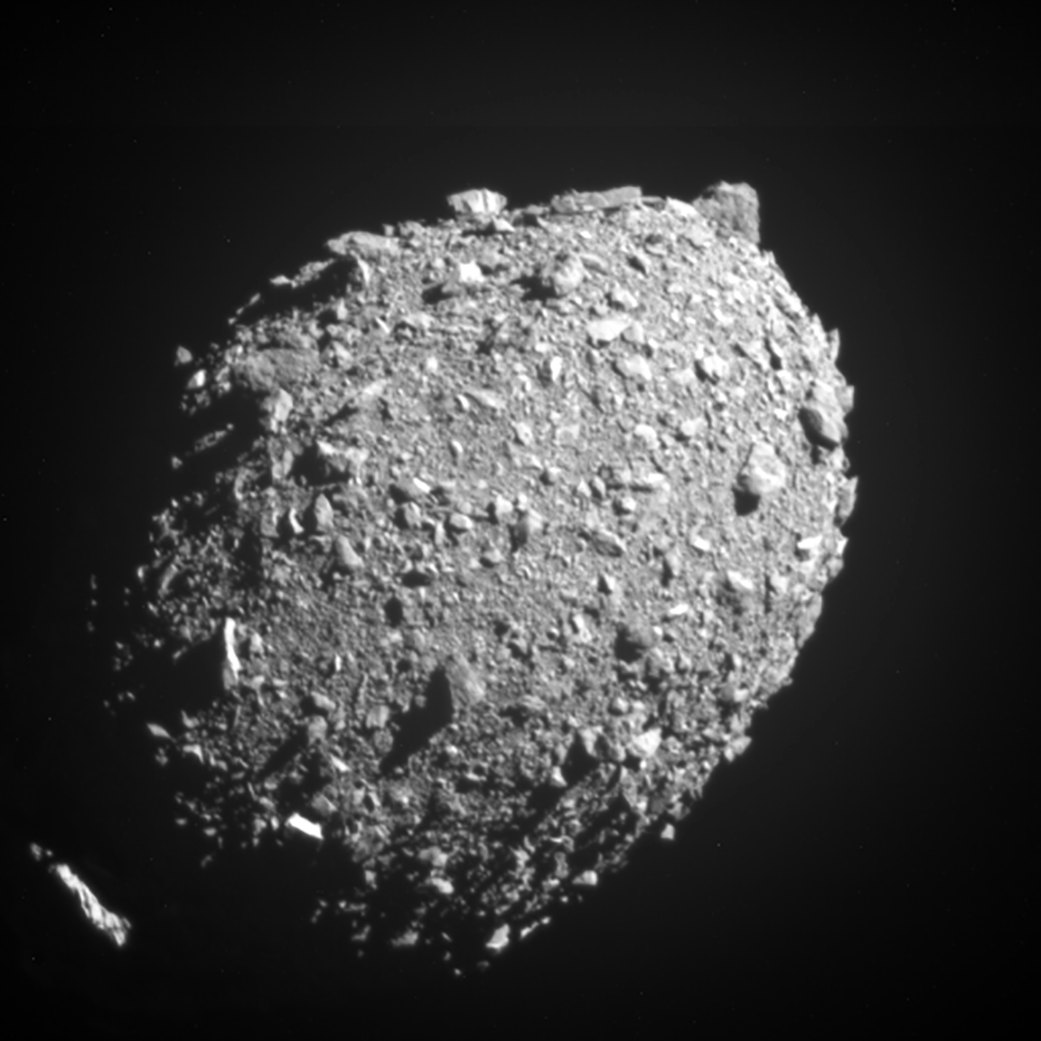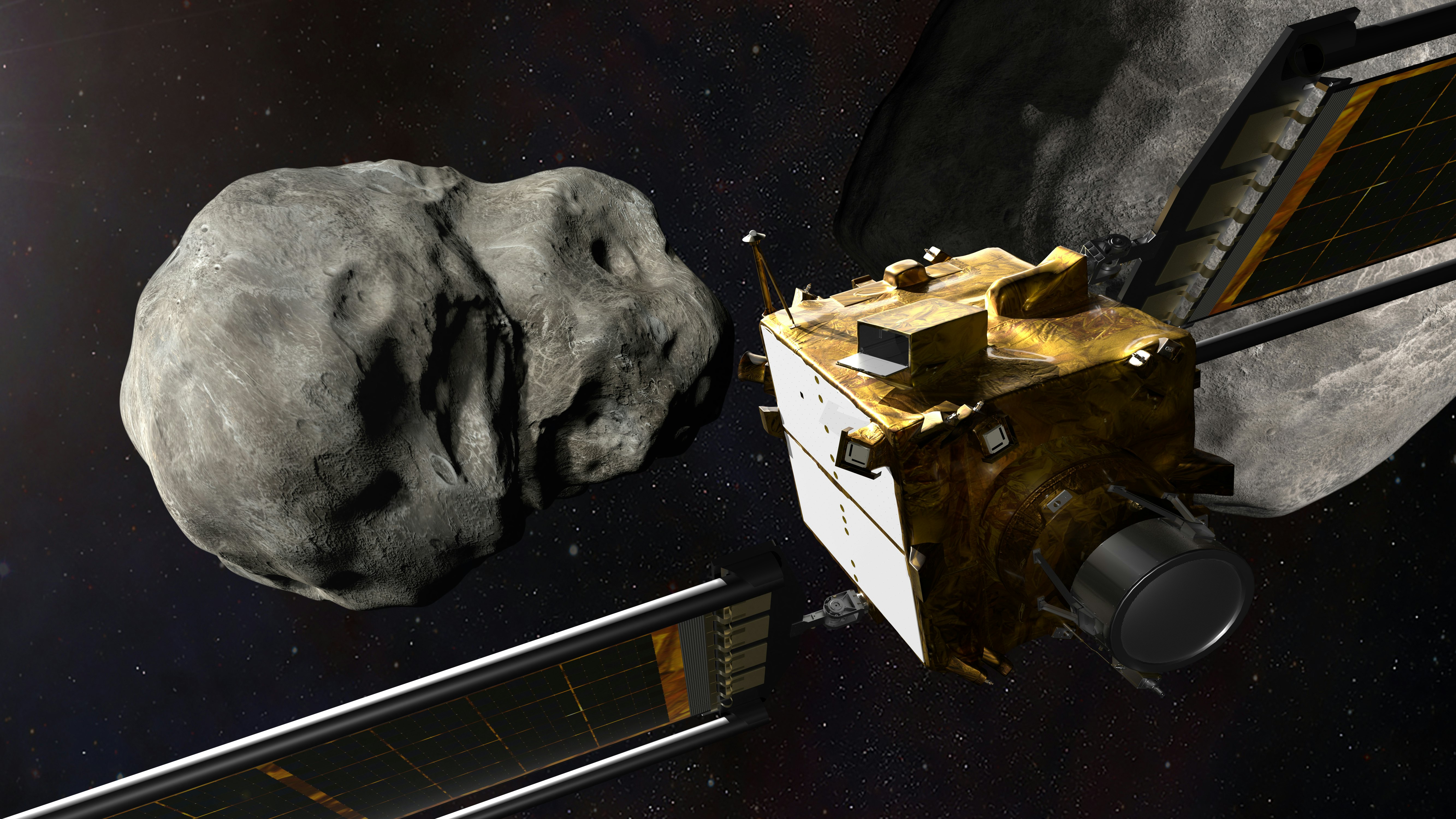
It was clear within hours of DART’s crash into the asteroid Dimorphos — the moonlet orbiting a larger asteroid, Didymos — that NASA’s first attempt at planetary defense was a success. But, from 6.8 million miles away, can we tell just how much of a success it was? That’s what a set of five papers published today in Nature by multiple international teams — covering every continent but Antarctica —have set out to find, and the answers are looking up for keeping future asteroids away from our home.
DART was a fairly small spacecraft, a roughly refrigerator-sized rectangular box with thrusters, a camera, and a pair of tiny satellites it ejected to watch the crash. But it still had a big impact–it altered Dimorphos’ orbit around Didymos from 11 hours and 55 minutes to 11 hours and 23 minutes. That’s a difference of 33 minutes, or about 4 percent.
If DART had been the only thing altering Dimorphos’ orbit, explains Cristina Thomas, an associate professor of astronomy at Northern Arizona University and lead author on one of the papers, “we would get an absolute minimum change of seven minutes.” But the rocks and rubble ejected from Dimorphos had a major effect, too. “We know there would be some amount of ejecta, and the question was going to be how much that ejecta changed, or–pun intended–impacted how we would see that orbital period change,” Thomas tells Inverse.
Jian-Yang Li, a senior scientist at the Planetary Science Institute and another lead author, tells Inverse that the impact of something like DART “causes an explosion that pushes a lot of ejecta out — their recoil force will push the asteroid, too. So that’s going to add momentum to the asteroid.”
Rubble pile asteroid meets its match

As DART approached Dimorphos, the striking images it sent back of the rubble-strewn surface first gave astronomers an idea of just how the impact was going to affect the moonlet. “As we were approaching Dimorphos, we could start to see what the object looked like in more and more detail, and we could see that it was a rubble pile, and it was going to have a lot of material that was going to be ejected,” Thomas says. “And that made us very excited because it made us think that this was going to be quite a large momentum enhancement, on the high end of the scale. We could really start to think about it more as a real place, a real object, a real effect.”
Terik Daly, a planetary scientist at the Johns Hopkins University Applied Physics Laboratory who worked on the team that designed and built DART’s camera and lead author on another of the papers, concurs. “We knew in the last few images we’d be able to resolve boulders and blocks the size of the spacecraft, even in the last couple of minutes,” Daly says. “We thought the last image would be a fine enough pixel scale that we could resolve the desk I’m working at if it were sitting on the asteroid. It’s one thing to know that in theory, but it’s another to see it in practice.”
DART, he says, ended up crashing into “this really interesting site with this juxtaposition of boulders, similar in size to parts of the spacecraft that made for a really exciting result in terms of the ejecta.”
When DART collided with Dimorphos, the ejecta formed a tail that trails behind the moonlet. These ejecta also give clues to the history of other asteroids, Li notes. While other asteroids with tails–known as active asteroids–have been observed, “there’s never been direct evidence of how impact would cause a tail.” After DART, astronomers have been able to see “how the ejecta is dispersed, how it’s pushed by sunlight” until it evolves into Dimorphos’ striking new tail.
But while tails are unusual, Dimorphos’ is especially so because of its shape, Li says. After a few days, the Hubble Space Telescope began sending down images of a spiral within the base of the tail’s cone, “and that feature is really unique, and only happens because we hit the moon of a binary asteroid.”
“The first time when I saw the images coming down from Hubble, in the second stage, and I saw the spirals, I couldn’t believe that we had this. I thought maybe something went wrong with the imaging, it could be some kind of artifact. And when I talked to the dynamicists, they informed me that it’s the only thing that can happen, that this would happen only in a binary system.”
Changing an asteroid’s orbit

DART impacted with the binary moonlet in particular in order to make an orbital change that would be detectable by instrumentation. The plan was the brainchild of Andy Cheng, the chief scientist of the APL’s Space Department. Despite DART’s success, he says, there are still a lot of questions about its results to answer.
Despite a close watch from Hubble and all sorts of Earth-based telescopes, the Didymos-Dimorphos system remains somewhat mysterious. To begin with, no one is exactly sure just how dense or massive Dimorphos is, although it’s somewhere in the neighborhood of 5 billion kilograms. That means that, while astronomers can see what DART’s 610 kilograms slamming into Dimorphos did to the moonlet’s orbital period, the amount of momentum it transferred in the process is still wide-open.
If DART had only conveyed its own momentum without any ejecta from Dimorphos flying off into space, it would have had what one of the teams calls a momentum enhancement factor of 1. If DART had succeeded beyond all wildest expectations, the maximum momentum enhancement factor it could have added was about 6. Right now, the teams can tell DART had an impact somewhere between 2.2 and 4.9, which means that most of the energy transferred actually came from ejecta — not from DART itself.
What’s next?
Astronomers will be able to get answers to some of these questions in just a few years. DART was originally imagined as part of a dual mission along with a companion, the European Space Agency’s Asteroid Impact Mission, which would have arrived in time to study the system before DART went crashing into Dimorphos. While AIM “just missed,” Cheng says, and was canceled, the idea was revived as Hera, which is planned to launch next fall.
“Hera will look for the crater that DART made, and if you can find the crater and measure how big it is that’s the best way of determining how much ejecta there was,” Cheng explains. “Or it’s possible there is no crater, and that instead of a crater, DART deformed the shape of Dimorphos. So that’s another question: what actually happened? That’s very important for the results.”
If Hera finds that DART’s impact really was as large as the initial numbers indicate, that might change the math on defending the Earth from asteroids. “By having this really large effect from the momentum of the ejecta,” Thomas says, “we are able to deflect asteroids potentially with less time, if we need to. In the past, you might have taken that seven minutes as the correct assumption of how the period would change, but that’s not the case.”
That’s good news for the Near Earth Object Surveyor, scheduled to launch in 2028 with the intention of discovering potentially hazardous asteroids 140 meters wide that might cross Earth’s orbit–along with tens of thousands of others, down to about 30 meters across. “We know asteroids are out there,” says Daly. “Can’t we do anything about it? And the answer from DART is a definitive ‘yes we can.’”







